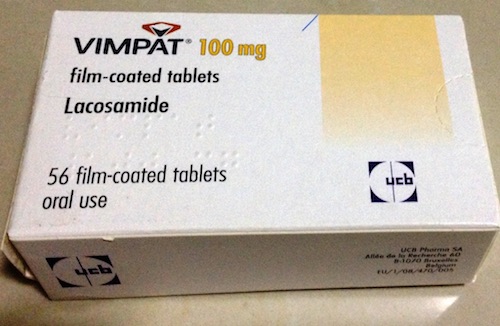
Vimpat® 100mg. By Yahia.Mokhtar. Licensed CC BY-SA 4.0 International.
On May 23, 2018, the Federal Circuit issued a decision in UCB, Inc. v. Accord Healthcare, Inc. (Before Prost, C.J., Bryson, and Stoll, J.)(Opinion for the court, Stoll, J.), a case arising under the Hatch-Waxman Act. The Appellees UCB, Inc. et al own and/or license U.S. Patent No. RE38,551., titled Anticonvulsant enantiomeric amino acid derivatives. The ‘551 patent covers lacosamide, an anti-epileptic drug for the treatment of epilepsy and other central nervous system disorders. UCB holds New Drug Applications (“NDAs”) that cover its lacosamide anti-epileptic drug approved by the Food and Drug Administration (“FDA”) and marketed under the tradename Vimpat®. The ‘551 patent is listed in the FDA’s Approved Drug Products With Therapeutic Equivalence Evaluations (“Orange Book”) as covering Vimpat®.
Appellants were generic drug manufacturers who filed Abbreviated New Drug Applications (“ANDAs”), seeking approval for generic versions of Vimpat®. Pursuant to applicable Hatch-Waxman provisions, Appellants certified in their ANDAs that the ‘551 patent was invalid, unenforceable, or that their proposed generic lacosamide products would not infringe the ‘551 patent.
Consequently, as is their right under Hatch-Waxman, UCB sued Appellants for patent infringement in the United States District Court for the District of Delaware. Appellants stipulated to infringement of claims 9, 10, and 13 of the ‘551 patent but maintained that these claims are invalid for obviousness-type double patenting, obviousness, and anticipation.
Following a bench trial, the district court made exhaustive fact findings based on the trial evidence and concluded that the asserted claims of the ‘551 patent were not invalid. Appellants appealled that decision, arguing that the district court misapplied the legal standards for obviousness-type double patenting, obviousness, and anticipation, and that the prior art anticipates and/or renders the ‘551 patent obvious.
The Federal Circuit held that the district court applied the correct legal standards in its obviousness-type double patenting, obviousness, and anticipation analyses, and found no clear error in its underlying factual findings. As a result, the Federal Circuit affirmed the district court’s ultimate conclusion that the asserted claims were not invalid.
Obviousness-Type Double Patenting
The Federal Circuit did not disturb the district court’s finding of no obviousness type double patenting, because UCB failed to show that a chemist would have been led to modify the compound described in the ‘301 patent, to create lacosamide according to the ‘551 disclosure. More specifically, no reference disclosed any anticonvulsant data for any compound comprising a methoxymethyl group at R3, including lacosamide.
Obviousness
The district court applied a two-part “lead compound analysis” to evaluate whether the new chemical compound would have been prima facie obvious over a known compound: 1) whether a chemist of ordinary skill would have selected the asserted prior art compounds as lead compounds or starting points; and 2) whether the prior art would have supplied one of ordinary skill in the art with a reason or motivation to modify a lead compound to make the claimed compound with a reasonable expectation of success.
Accord argued that the chemistry here, which concerned purifying a mixture, does not require a lead compound analysis. The Federal Circuit agreed but stipulated that no authority prohibited a lead compound analysis either. The lower court did not erroneously find that a person of ordinary skill would not have been led to select a lead compound from the references, because there was a lack of data supporting them, and expert testimony discouraged their use.
Anticipation
The Federal Circuit further found that the claims were not anticipated, because a broader genus of compound cited in the prior art reference did not disclose separation into the more narrow species cited in claim 9 of the ‘551 patent.
Chief Prost dissenting
Chief Judge Prost disagreed with the majority’s obvious-type double patenting analysis. While she noted the majority’s recognition of substantial evidence against a reasonable expectation of success in creating a functionalized amino acid (“FAA”) with anticonvulsant activity by selecting an unsubstituted benzyl for R and unsubstituted methyl for R1, she also noted experiments to the contrary that the majority ignored. Further, the contrary experiments were comparable or more promising than others tested. Prost also wrote that the majority failed to include one of the references in its obvious-type double patenting analysis.
Take Away
It was not reversible error for the district court to apply a lead compound analysis to evaluate the obviousness of a compound obtained by purifying mixtures. In that type of analysis, the prior art must provide a reason to modify a known lead compound, in order to obtain the claimed compound with a reasonable likelihood of success.

![[IPWatchdog Logo]](https://ipwatchdog.com/wp-content/themes/IPWatchdog%20-%202023/assets/images/temp/logo-small@2x.png)

![[[Advertisement]]](https://ipwatchdog.com/wp-content/uploads/2023/01/2021-Patent-Practice-on-Demand-1.png)


![[Advertisement]](https://ipwatchdog.com/wp-content/uploads/2024/04/Patent-Litigation-Masters-2024-sidebar-early-bird-ends-Apr-21-last-chance-700x500-1.jpg)

![[Advertisement]](https://ipwatchdog.com/wp-content/uploads/2021/12/WEBINAR-336-x-280-px.png)
![[Advertisement]](https://ipwatchdog.com/wp-content/uploads/2021/12/2021-Patent-Practice-on-Demand-recorded-Feb-2021-336-x-280.jpg)
![[Advertisement]](https://ipwatchdog.com/wp-content/uploads/2021/12/Ad-4-The-Invent-Patent-System™.png)







Join the Discussion
One comment so far.
Santh
June 6, 2018 12:39 amHave you read “The captured economy”? It’s by polisci profs out of Johns Hopkins and looks at four segments of the economy, one of which is IP law and how, quote: “Patent protection, some of which can more fairly be described as patent trolling, raises new companies’ cost of doing business, with questionable and perhaps even nonexistent benefits for innovation overall” (from the atlantic article on the book, politics aside). Could be a good read.